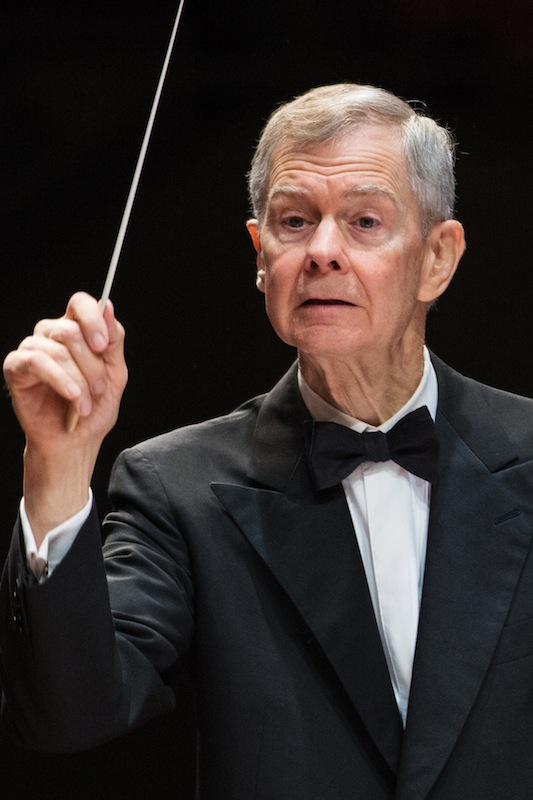New England Philharmonic serves up smart and spooky Halloween program

Richard Pittman conducted the New England Philharmonic Saturday night at the Tsai Performance Center.
It’s that time of year when people dress up in costumes and roam the streets looking for a party. Lovers of classical music looking for festivities of their own turned up at the Tsai Performance Center Saturday night, when Richard Pittman and the New England Philharmonic offered Halloween-themed treats by Schwantner, Child, Norman, and Stravinsky.
The program of 20th- and 21st-century music is typical fare for this adventurous ensemble, and the orchestra played all the works with panache. Recent seasons have shown dramatic improvements in the quality of the NEP’s performances. Textures and phrases were clearly articulated, and the musical contrasts were well judged.
The orchestra’s finest playing came in Joseph Schwantner’s Magabunda. Based upon poems by Agueda Pizarro, the four songs of this set, sung in English and Spanish, reflect both mystical and lush poetic images.
Some of the texts revel in ecstatic spiritualism. Others muse upon death and new birth, and Schwantner’s music brings it all to vivid life. Composed in 1983, Magabunda mixes passages of heavy dissonance with episodes of sweeping romanticism in an eclectic style that recalls the music of George Rochberg.
“Shadowinnower” unfolded in jagged melodies and pointillisms. Soprano Sarah Pelletier handled her part with dexterity and a bright tone to build the music to rousing heights. “Blancolvido” (“White Oblivion”) featured colorful orchestration, including tuned water glasses and a water gong. “Witchnomad” resonated with haunting glow. Pelletier’s sung and narrated lines had the intensity of incantation.
But the most beautiful music came in the third song of the set, “Black Anemones,” which flowed with tender lyricism. Pelletier’s voice here beamed with a faint light, and the orchestra delivered a reading of warmth and conviction.
The only non-Halloween work on the program was Andrew Norman’s Sacred Geometry, which won the New England Philharmonic’s Call-for-Scores competition in 2003. Norman’s star has ascended since then, but this short curtain raiser, written when the composer was in his mid-twenties, already showed promise of a creative musical mind.
The work casts images of the Chartres Cathedral in sound. Dissonances are used to paint vivid pictures of spires and the church’s cavernous space. Chords in this piece hang in the air like light through a church window. But there’s a hint of melody that emerges midway through the work. English horn and bassoon engage in a chant-like theme, but the line comes to rest on sustained notes that result in a staggered flow, as the music seems to get stuck in stone.
Pittman led a reading of radiant energy to make a strong case for the work.
Stravinsky’s Petrushka is a bold undertaking for many orchestras due to its grinding mixed meters and exposed textures. The New England Philharmonic’s energetic reading of this well-known score—the second performance heard in Boston this past week—made for an engaging listening experience.
Pittman opted for fleet tempos, which resulted in passages of sparkling intensity. The Shrovetide Fair that opens the piece was aptly festive.
But there were a few moments of imprecision. The cello melody in the opening passage missed the singing quality needed to pull the line off effectively, and string entrances lacked cohesion in a few places.
The winds, for the most part, had a stellar night. The magician’s flute solo floated effortlessly in the air, and the tuba supplied weight to the dancing bear scene. A few unfortunate cracked notes marred an otherwise creamy rendition of the trumpeter’s Ballerina solo.
Peter Child’s Punkie Night, which opened the second half of the concert, made for a bit of eerie fun. This short work, which conjures a British Halloween celebration, is rife with strange sounds. Woodwinds burble, brasses growl, and percussion adds distant shrieks. The audience is even called upon to supply their own vocal calls at work’s end.
When Pittman turned around on the podium to direct the audience, listeners unleashed a barrage of howls, whistles, and shouts. It was a somewhat corny addition to the piece, but ’tis the season for pranks and laughter.
Richard Pittman will lead the New England Philharmonic in music by Adams, Copland, and Stookey 3 p.m. December 10 at the Tsai Performance Center. nephilharmonic.org
Posted in Performances